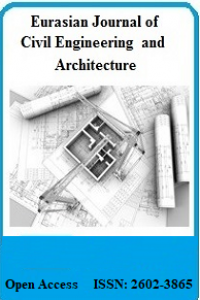SURFACE FLOW, URBAN AND LAND-BASED POLLUTION LOADS IN DAVUTLAR BAY
SURFACE FLOW, URBAN AND LAND-BASED POLLUTION LOADS IN DAVUTLAR BAY
Coastal areas are heavily influenced by human actions such as urbanization of natural and agricultural areas. Besides pollution loads in discharges of the urban and industrial wastewater, loads washed off from the land are the main sources of coastal pollution, both of which can have deteriorating effect for the environment. The point and non-point pollutants have become a growing concern for Davutlar bay, a tourism district in the eastern Aegean Sea urbanized in the last decades. In order to reduce the pollution in the bay, the construction of a wastewater treatment plant has started in 2013. In this study, the surface discharges from the surrounding basin towards the bay are modelled and the pollutants buildup in surrounding basin are calculated by using Environmental Protection Agency’s Storm Water Management Model (SWMM) for the year 2018 considering different landuses defined in the CORINE system. The wastewater pollutants, namely total suspended solids (TSS), biological oxygen demand (BOD), chemical oxygen demand (COD), total nitrogen (NT) and total phosphorus (PT); discharged from the urban area to the bay are calculated before and after the wastewater treatment plant began to operate in 2018. The effects of land-based pollutants and the reducing effect of the wastewater treatment plant for the coastal pollution are discussed in the projections for the year 2019.
Keywords:
Coastal Pollution, CORINE Runoff, Water Quality,
___
- AATTUT. (2010). “Atıksu Arıtma Tesisleri Teknik Usuller Tebliği”. T.C. Resmi Gazete, 27527, 20 March 2010.
- Ascher, U.M. and Petzold, L.R. (1998). “Computer Methods for Ordinary Differential Equations and Differential-Algebraic Equations”, Society for Industrial & Applied Mathmatics, Philadelphia.
- ASKI. (2017). “2017 Faaliyet Raporu”. Aydın Su ve Kanalizasyon İdaresi Genel Müdürlüğü, Aydın Büyükşehir Belediyesi, Aydın.
- ASTER GDEM Validation Team. (2011). ASTER Global Digital Elevation Model Version 2, Summary of Validation Results. METI & NASA, 26pp.
- Cebe, K. and Balas, L. (2018). “Monitoring and modeling land-based marine pollution”. Regional Studies in Marine Science, 24, 23-39.
- ESRI. (2013). ArcGIS Desktop: Release 10.2. Redlands, CA: Environmental Systems Research Institute.
- Gironás, J., Roesner, L.A. and J. Davis. (2009). “Storm Water Management Model Applications Manual”. National Risk Management Research Laboratory, Office of Research and Development, USEPA, EPA/600/R-09/000, Ohio, USA.
- Google Earth. (2018). Davutlar bay, 37°43'49.63"N, 27°17'27.10"E. Primary data layer, https://earth.google.com [Accessed 12 October 2018].
- Press, W.H., Teukolsky, S.A., Vetterling, W.T., and Flannery, B.P. (1992). “Numerical Recipes in C”, Second Edition, Cambridge University Press.
- Rossman, L. and Huber, W. (2015). “Storm Water Management Model Reference Manual Volume I, Hydrology”. USEPA Office of Research and Development, EPA/600/R-15/162A , Washington, DC, USA.
- Rossman, L. (2017). “Storm Water Management Model Reference Manual Volume II – Hydraulics”. U.S. Environmental Protection Agency, EPA/600/R-17/111, Washington DC, USA.
- TURKSTAT. (2018). Database, Turkish Statistical Institute, http://www.tuik.gov.tr/PreTabloArama.do?metod=search&araType=vt [Accessed 13 March 2018].
- TÜBİTAK MAM. (2010). “Havza Koruma Eylem Planlarının Hazırlanması Projesi, Büyük Menderes Havzası, Proje Nihai Raporu”, Cilt 1, 5098115, çe.10.49, Türkiye Bilimsel ve Teknolojik Araşırma Kurumu, Marmara Araştırma Merkezi, Çevre Enstitüsü.
- Başlangıç: 2017
- Yayıncı: Serkan ŞAHİNKAYA
Sayıdaki Diğer Makaleler
Ayşe EDİNÇLİLER, Yasin Sait TOKSOY
SURFACE FLOW, URBAN AND LAND-BASED POLLUTION LOADS IN DAVUTLAR BAY
EFFECT OF LIME ON UNCONFINED COMPRESSIVE STRENGTH OF A LOW PLASTICITY CLAYEY SOIL
Mustafa KARASAHİN, Erdinç KESKİN, İlker ŞAHİNOĞLU
EXAMINING THE COMPONENTS OF GREEN BUILDING DESIGN AND ITS MANAGEMENT SYSTEM
Mohammad BEYKZADE, Sepide BEYKZADE
INVESTIGATION OF FLUID-STRUCTURE INTERACTION BY USING SOLIDITY RATIO
Begum Yurdanur DAGLİ, Yesim TUSKAN, Dilay UNCU
